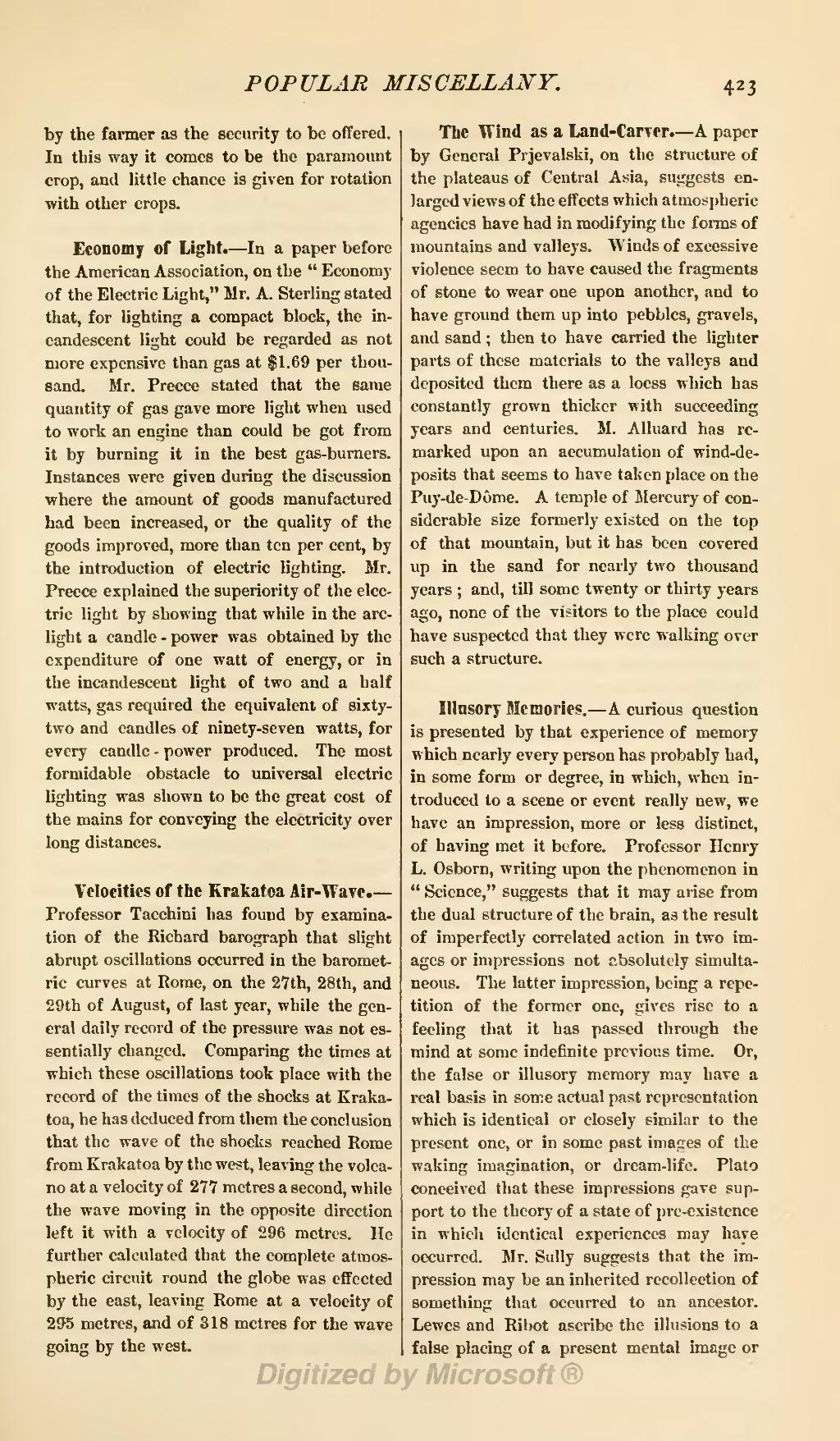by the farmer as the security to be offered. In this way it comes to be the paramount crop, and little chance is given for rotation with other crops.
Economy of Light.—In a paper before the American Association, on the "Economy of the Electric Light," Mr. A. Sterling stated that, for lighting a compact block, the incandescent light could be regarded as not more expensive than gas at $1.69 per thousand. Mr. Preece stated that the same quantity of gas gave more light when used to work an engine than could be got from it by burning it in the best gas-burners. Instances were given during the discussion where the amount of goods manufactured had been increased, or the quality of the goods improved, more than ten per cent, by the introduction of electric lighting. Mr. Preece explained the superiority of the electric light by showing that while in the arc-light a candle-power was obtained by the expenditure of one watt of energy, or in the incandescent light of two and a half watts, gas required the equivalent of sixty-two and candles of ninety-seven watts, for every candle-power produced. The most formidable obstacle to universal electric lighting was shown to be the great cost of the mains for conveying the electricity over long distances.
Velocities of the Krakatoa Air-Wave.—Professor Tacchini has found by examination of the Richard barograph that slight abrupt oscillations occurred in the barometric curves at Rome, on the 27th, 28th, and 29th of August, of last year, while the general daily record of the pressure was not essentially changed. Comparing the times at which these oscillations took place with the record of the times of the shocks at Krakatoa, he has deduced from them the conclusion that the wave of the shocks reached Rome from Krakatoa by the west, leaving the volcano at a velocity of 277 metres a second, while the wave moving in the opposite direction left it with a velocity of 296 metres. He further calculated that the complete atmospheric circuit round the globe was effected by the east, leaving Rome at a velocity of 295 metres, and of 318 metres for the wave going by the west.
The Wind as a Land-Carver.—A paper by General Prjevalski, on the structure of the plateaus of Central Asia, suggests enlarged views of the effects which atmospheric agencies have had in modifying the forms of mountains and valleys. Winds of excessive violence seem to have caused the fragments of stone to wear one upon another, and to have ground them up into pebbles, gravels, and sand; then to have carried the lighter parts of these materials to the valleys and deposited them there as a loess which has constantly grown thicker with succeeding years and centuries. M. Alluard has remarked upon an accumulation of wind-deposits that seems to have taken place on the Puy-de-Dôme. A temple of Mercury of considerable size formerly existed on the top of that mountain, but it has been covered up in the sand for nearly two thousand years; and, till some twenty or thirty years ago, none of the visitors to the place could have suspected that they were walking over such a structure.
Illusory Memories.—A curious question is presented by that experience of memory which nearly every person has probably had, in some form or degree, in which, when introduced to a scene or event really new, we have an impression, more or less distinct, of having met it before. Professor Henry L. Osborn, writing upon the phenomenon in "Science," suggests that it may arise from the dual structure of the brain, as the result of imperfectly correlated action in two images or impressions not absolutely simultaneous. The latter impression, being a repetition of the former one, gives rise to a feeling that it has passed through the mind at some indefinite previous time. Or, the false or illusory memory may have a real basis in some actual past representation which is identical or closely similar to the present one, or in some past images of the waking imagination, or dream-life. Plato conceived that these impressions gave support to the theory of a state of pre-existence in which identical experiences may have occurred. Mr. Sully suggests that the impression may be an inherited recollection of something that occurred to an ancestor. Lewes and Ribot ascribe the illusions to a false placing of a present mental image or
